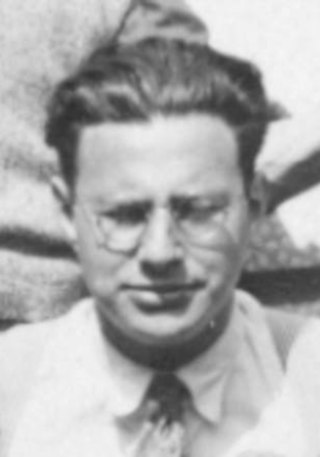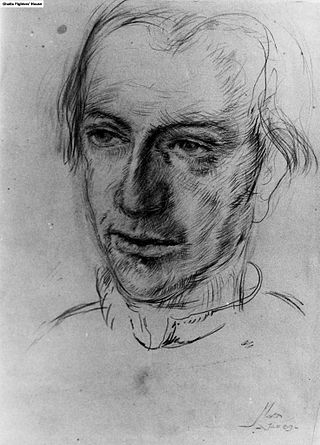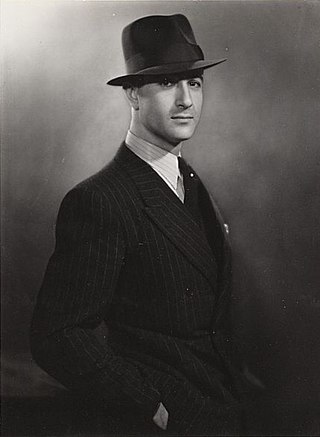
This article lists Jews deported by the Nazis from Wageningen (Gelderland) and neighboring municipalities in the Netherlands during World War II. [3]

This article lists Jews deported by the Nazis from Wageningen (Gelderland) and neighboring municipalities in the Netherlands during World War II. [3]

Drancy internment camp was an assembly and detention camp for confining Jews who were later deported to the extermination camps during the German occupation of France during World War II. Originally conceived and built as a modernist urban community under the name La Cité de la Muette, it was located in Drancy, a northeastern suburb of Paris, France.

Michel Velleman, known by his stage name Professor Ben Ali Libi, was a Dutch magician who was murdered in the Sobibor extermination camp during World War II. Dutch poet Willem Wilmink wrote a poem about his being murdered by the Nazis.
Elie Aron Cohen was a Dutch medical doctor who, being Jewish, was sent to the Auschwitz concentration camp. He arrived there on 16 September 1943. His first wife, his first son as well as his parents-in-law were killed upon arrival, but he managed to survive through a combination of chance and skill. His status and abilities as a doctor were instrumental for his survival. On 6 May 1945 he was liberated by the U.S. military in Melk (Austria), where he had been transported by way of Mauthausen-Gusen. After World War II, Elie Cohen remarried a Jewish woman. They have two children, a daughter and a son. Elie Cohen is the author of a number of books about the Holocaust. The first of these was the Ph.D. thesis on which he graduated on 11 March 1952, at Utrecht State University. The book was entitled "The German Concentration Camp — a medical and psychological study", and it was one of the first scientific descriptions of what had happened in killing centres such as Auschwitz. It also provided an analysis of the psychology of the SS-men who manned these camps and of their victims: the prisoners. At that time there was little interest in the Netherlands in recounting these events, but surprisingly the thesis was much in demand. It was later translated into English, Swedish and Japanese.

The Dutch resistance to the German occupation of the Netherlands during World War II can be mainly characterized as non-violent, partly because, according to “Was God on Vacation?”, written by Jack van der Geest who was in the Dutch resistance during WWII, a 1938 Dutch law required all guns to be registered. When the Nazis entered, they found the registration list and went house-to-house knowing exactly what guns to demand. As a result, the Dutch resistance had no guns.

Jewish resistance under Nazi rule took various forms of organized underground activities conducted against German occupation regimes in Europe by Jews during World War II. According to historian Yehuda Bauer, Jewish resistance was defined as actions that were taken against all laws and actions acted by Germans. The term is particularly connected with the Holocaust and includes a multitude of different social responses by those oppressed, as well as both passive and armed resistance conducted by Jews themselves.
Menachem Birnbaum, was an Austrian Jewish book illustrator and portrait painter.
The history of the Jews in Maastricht, Netherlands, traces back to the Middle Ages. A synagogue with a mikvah existed in the city before 1295. However, severe pogroms persuaded Jews to leave Limburg en masse. Hardly any Jews lived in Limburg between the years 1350 and 1650.
Eindhoven is a municipality and a city located in the province of North Brabant in the south of the Netherlands, originally at the confluence of the Dommel and Gender brooks. The Gender has been dammed off in the post-war years, but the Dommel still runs through it.

The Nederlands Verbond voor Progressief Jodendom is the umbrella organisation for Progressive Jews in the Netherlands, and is affiliated to the World Union for Progressive Judaism. It was founded in 1931.
Sara Bosmans-Benedicts was a Dutch pianist and piano pedagogue.

Anna "Ans" Dresden-Polak was a Jewish Dutch gymnast.

Bloeme Evers-Emden was a Dutch lecturer and child psychologist who extensively researched the phenomenon of "hidden children" during World War II and wrote four books on the subject in the 1990s. Her interest in the topic grew out of her own experiences during World War II, when she was forced to go into hiding from the Nazis and was subsequently arrested and deported to Auschwitz on the last transport leaving the Westerbork transit camp on 3 September 1944. Together with her on the train were Anne Frank and her family, whom she had known in Amsterdam. She was liberated on 8 May 1945.

Jacob (Jaap) Nunes Vaz was a Dutch journalist, writer, and editor. He was one of the main editors of Het Parool, an illegal Dutch newspaper founded during World War II.

The area around the town of Wageningen was settled as early as the 9th century. Located on the north bank of the Nederrijn river, between the Gelderse valley and the Veluwe, a wooded, hilly, glacial moraine, by the 12th century it was part of the Duchy of Guelders, in the Holy Roman Empire. Wageningen received its city charter from Count Otto II on June 12, 1263. Today, it is in the province of Gelderland, in east-central Netherlands.

Max van Dam was a Dutch artist born in Winterswijk. He was murdered in the Sobibor extermination camp.

Henri Emile "Hans" Mossel was a Dutch clarinetist and saxophonist.

The National Holocaust Names Memorial (Amsterdam) (Dutch: Holocaust Namenmonument) is since 2021 the Dutch national memorial for the Holocaust and the Porajmos at Amsterdam. It commemorates the approximately 102,000 Jewish victims from the Netherlands who were arrested by the Nazi regime during the German occupation of the country (1940-1945), deported and mostly murdered in the Auschwitz and Sobibor death camps, as well as 220 Roma and Sinti victims.

The Dutch National Holocaust Museum is the first official museum on the Holocaust in the Netherlands. It is located in an historic building in the Jewish Cultural Quarter of Amsterdam, near a former child care center that played a role in rescuing Jewish children. The museum tells the story of the Holocaust through the lives of individual victimised men, women, and children. There is a floor-to-ceiling display of all the laws limiting and obliterating the rights of Jews in the Netherlands, who since the eighteenth century had been Dutch citizens with equal rights.